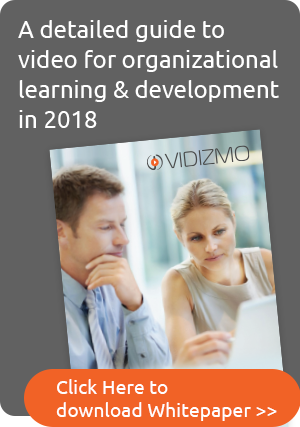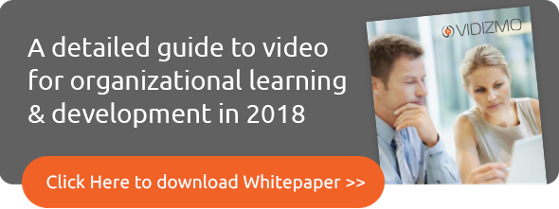The LMS is a critical component of any organization’s training and learning strategy. For many years, L&D professionals focused on learning management systems as the core and center of all corporate learning. However, with changing learning needs, this is no longer the case.
There is no arguing that LMS solutions continus to play a vital role in organizational learning for various key reasons. Learning management systems are a large ecosystem that manages a big portion of online learning and development and give organizations the ability to scale their L&D efforts in highly structured and comprehensive manner.
However, as far as video capabilities are concerned, the LMS falls short in terms of various platform features and functionalities simply because it is not designed to support or manage video.
However, the proliferation of video content in organizational learning and development necessitates that L&D teams are equipped with a comprehensive solution designed to capture, stream, transcode, store, search, manage, and distribute video content while also resolving any video-related issues or video delivery bottlenecks, using specialized streaming video technologies.
The LMS, which is mainly designed to support text documents and learning media other than video, is not equipped with the ability to manage the relatively massive video file size and associated challenges with format compatibility, bandwidth congestion, and playback quality, not to mention evolving user-level requirements such as in-video search to quickly locate content using closed captions or the spoken words in a video.
Even the LMS solutions that do support video only offer basic foundational video storage or playback capabilities that are not enough to support the advanced video use cases for contemporary L&D activities. While a limited number of more advanced LMS like SAP, Oracle and Workday provision some basic video support and light video authoring tools, they still do not meet the aforementioned dynamic L&D video needs./p>
Moreover -- as of this writing -- none of the LMS solutions support a simple YouTube-like video interface, playback, and video experience needed to make video an everyday learning tool for your employees.
In fact, here is how Deloitte’s Josh Bersin articulates the challenge he most commonly sees L&D teams face in regards to using an LMS as a modern learning tool:
“As I talk with companies all over the world I hear a continuous story that "employees simply do not use the LMS unless they have to," and this has caused a lot of pain in L&D. Companies spend millions of dollars on these systems and to find that employees don't use them is a painful process. It also impacts employees' perceptions of the HR and L&D department. Perhaps largely because of the state of the LMS market, our [Deloitte’s] newest research (High-Impact Learning Organization 2017) shows that employees we surveyed rate the L&D department a -8 Net Promoter score (extremely low).”
Most LMS solutions were designed to suit the traditional content model that involved text, visuals, SCORM, etc. - but not video. Moreover, LMS platforms are built on the course catalog paradigm best suited for formal education, but is losing relevance in modern learning models and practices.
An enterprise video platform or a video learning content management system (LCMS) that comprehensively manages all video capture, streaming, storage, delivery, and distribution in a powerful yet easy-to-use YouTube-like video platform, designed to support the modern learner's needs.
Things to look for in a video learning platform
Contemporary corporate learning is about your employee's learning experience, and L&D teams need to ask themselves the following questions to determine the vability of any modern-day video learning platform.
- Is your learning platform easy to use and seamlessly incorporated to promote everyday learning? Does it provide a simple yet engaging user experience that is conducive to video-based learning?
- Does your platform provide a seamless video playback experience on all user devices, including smartphones and tablets?
- Is this platform capable of managing video streaming, storage, distribution to internal and external stakeholders?
- Can this platform manage bandwidth and network challenges to support smooth video playback to users in all your office locations?
- Does this platform promote micro learning or everyday just-in-time learning?
- Does this platform support user-generated content or ease of content creation and publishing for authorized users across the organization?
- Does this platform promote collaborative learning and interactive learning feature within video?/li>
- Does this platform support powerful search capabilities to deliver highly relevant and accurate search results in seconds? Does it support search inside video content?
- Does it provide automatic transcription of all videos?/li>
- Can this platform provide micro and macro video analytics, everything from detailed user-level video usage reports to overall statistical trends about how people engage with different types of content?
- And most importantly, is it a platform your employees would like to access for self-learning – a platform they would like to visit on their own instead of being asked to or assigned?
In the case of most corporate LMS, the answer to the above questions is no because the LMS is not tailored to support all the above-mentioned video and platform capabilities. The LMS serves a specific function, which is to provide a more traditionally structured form of trackable learning or assigned training and tasks that are required from employees.
As a result, LMS systems tend to be difficult to use, and most employees find them of limited values when it comes to modern ways and tools for learning. For most companies today, your LMS offers great opportunities to drive value with eLearning – except in the case of video learning.
For all video-based learning, your organization needs an enterprise video platform that comprehensively addresses all video learning needs in a single solution built and tailored to serve video learning needs.
How VIDIZMO’s video platform complements your LMS
Organizations across the board use enterprise video platforms to manage video learning content. While LMS solutions continue to play a vital role in enabling various forms of organizational learning activities, video platforms are now required for video-based eLearning to reduce learning costs, modernize learning strategies, optimize time, improve employee learning experience, and engage them in socially interactive forms of learning.
In this way, a video platform complements and provides support to an LMS so learning and development teams can efficiently scale their video learning activities without having to be concerned with the specifics of video technicalities and ensuing video execution and management troubles.
To enable this, video platforms like VIDIZMO provide seamless interoperability with most industry-acclaimed learning management systems such as SAP Success Factors, Oracle Taleo, Workday, Saba, Docebo, CANVAS, Adobe Captivate, D2L, Moodle, Blackboard, and more. VIDIZMO does this by offering flexible, out-of-the-box integrations with most LMS solutions and custom integrations with others, as per your organizational needs. This way, VIDIZMO allows you to leverage your LMS while delivering all your video-based learning.
As part of this integration, VIDIZMO can consolidate, update and share the changes made in an LMS by automating the task of getting content from LMS to VIDIZMO. For instance, detailed video analytics collected by VIDIZMO based on user’s viewing activity can be automatically reporting within the LMS to analyze course completion or what portion of the video was viewed. Similarly, VIDIZMO can also take course assignment instructions from an LMS and feed that into VIDIZMO so users can for instance, get notifications for any unwatched assigned video. In another scenario, VIDIZMO can also integrate with the LMS to determine which video should be suggested to the viewer based on their LMS records such as their relevant field or specialty, so that related content can be shown to the viewer in VIDIZMO.
Such powerful integrations between VIDIZMO and your LMS can result in highly efficient and optimal learning outcomes for the viewers as well as the L&D teams. More importantly, the resulting personalization of content for the learner can go a long way in establishing a seamless flow of everyday relevant learning for viewer based on their credentials while also engaging them with content that is best suited for their learning needs.
As part of this integration, another thing to keep in mind is that your learners expect to receive different types of content in a video learning platform as compared to an LMS. While an LMS may be expected to house long-form learning courses or programs for macro learning, a video platform’s core use is for every day learning, which means it must contain more of micro-learning videos, just-in-time learning videos, and shorter, more personalized versions of longer form courses stored in the LMS. This way, a video platform – in integration with your LMS – delivers content customized for a user’s everyday learning needs in a personalized manner, along with with suggestions for recommended content based on their previous activity, video liked, user profiles in the LMS, etc.
For other platform integrations, VIDIZMO provides out-of-the-box interoperability with SCORM-compliant content; other CMS like SharePoint, Drupal, WordPress, Jive, Sitecore, etc.; CRM such as Salesforce, Microsoft Dynamics etc.; video conferencing tools like Skype for Business, WebEx, Go-To-Meeting, Cisco TelePresence, Polycom RealPresence etc.
VIDIZMO also provides custom integrations to support any organizational needs to maintain a seamless, blended and coherent learning experience for L&D teams and learners across organizations.
To know more about how VIDIZMO can integrate with your LMS or how you can incorporate video in your learning strategy, contact us today or read our whitepaper, a detailed guide to video for organizational learning and development in 2018.
For more on how your organization can use video, read our blog 51 business video use cases in the modern enterprise.
Posted by Rabeea Tahir
Rabea Tahir is Technology Content Strategist at VIDIZMO which is a Gartner recognized enterprise video content management system, to stream live/on-demand media to both internal and external audiences, on-premise, Azure or AWS cloud. VIDIZMO solutions are used by enterprises, government, local, state government, healthcare, law enforcement agencies, justice, public safety, manufacturing, financial & banking industry.




